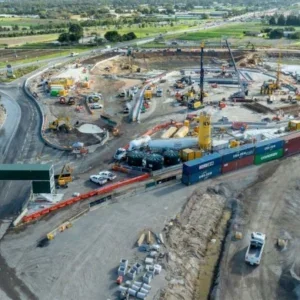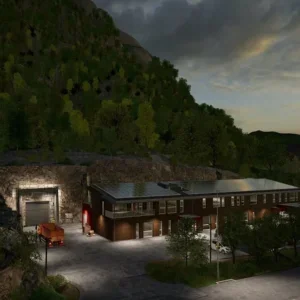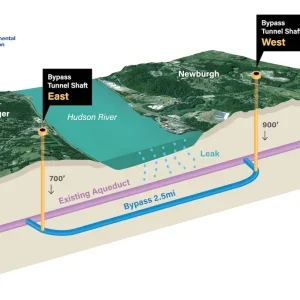It takes just one intense rainstorm to leave parts of Washington D.C.’s First Street treacherously flooded. This quiet residential community in the city’s northwest has seen sewer overflows overwhelm its streets and sidewalks.
The District of Columbia Water and Sewer Authority (DC Water) and the mayor expedited construction of the First Street Tunnel, part of the Anacostia River Tunnels Project, to relieve floods and provide storage in the neighborhood until a much larger part of the new system is completed.
Mitigating the effects of construction on the community has been a top priority for the design-build team of Skanska-Jay Dee (SKJD) and its subcontractor Moretrench. A unique ground freezing installation will keep progress on this urgent project moving swiftly and reduce the strain of major construction work on its neighbors.
Originally slated for construction after the 5-mile (8.2km) Northeast Boundary Tunnel, officials fast-tracked this smaller project ahead by eight years. The USD 157M First Street Tunnel, is now expecting completion in April 2016.
"During the first eight years of the project it is going to operate as a big storage tank and then it will turn into a conveyance tunnel after the Northeast Boundary Tunnel is completed," explains Mike DiPonio, of SKJD.
Work includes a 2,700ft- (823m) long tunnel, 20ft (6m) in diameter, which will be mined by one TBM. There are four shafts, three adits and four diversion chambers among other structures. A shallow utility trench feeds pipes and communication and electric cables from the main worksite, south to three more shafts offset along the alignment (Figure 1). This is a 27-month contract for both designing and building the project.
SKJD is working in association with Parsons Brinckerhoff for design. Jacobs Associates is part of DC Water’s program management team for tunnel and geotechnical engineering services for the entire Anacostia River Tunnels project. Once completed, the First Street Tunnel will provide DC Water with 8 million gallon capacity of overflow storage until the Northeast Boundary Tunnel is completed.
Headquarters
The main shaft, at Channing Street, has a 64ft (19.5m) diameter and reaches a 160ft (48.8m) depth. Located at a former sand filtration facility, this approximately 300ft by 300ft (91.5m) site has considerably more space compared to the other three — enough for the JV to install slurry walls for the shaft’s excavation. From here, the TBM will be launched, all muck will be removed, all of Moretrench’s plants circle brine through freeze pipes and several natural gas generators power the entire project.
"Everything stays up here at the Channing Street site. That is one of our community mitigation measures," explains Bianca Messina, a section engineer with SKJD. Others include a 24-hour hotlines, alternative parking areas, and a parking shuttle service for residents. The 4ft- (1.2m-) deep utility trench, buried in April-September 2014, is one measure that helps reduce construction noise in the neighborhood and keeps the three southern job sites more compact.
The utility trench follows the alignment, about 150ft (46m) to the west, and contains the piping that supply and return brine from Channing Street to the three work sites. "Typically in a ground freezing application the freeze system is located directly adjacent to the shaft," says Adam Curry, project manager with Moretrench, who helped design the system.
"Here, we’re anywhere from 300ft to 2,600ft (90 to 792m) away."
There are three, 150t moblile refrigeration units that run off the JV’s natural gas substations, using four 50hp pumps to move the calcium chloridebased brine down to the three sites and back. The brine passes through filters where any impurities are cleaned, and then through instrumentation before being siphoned off into one of three plants for cooling. "Right now we’re running about 1,000 gallons per minute, and running about -28oC coming in -31oC going out," Curry says.
"One of the key aspects of this whole system is integrating all of the instrumentation into one central location and then you can access this remotely," he explains in a nearby trailer housing several computers. "We have different operating parameters from each of the plants sent here via Ethernet cable. We’ve got supply temperatures from each plant, brine levels, pressures, flows, for example."
All three shafts being frozen are about 23ft (7m) id, and about 160ft deep. There are three adits being frozen, ranging from 80 to 100ft (24 to 30.5m) deep. Moretrench is using foam insulation for the freeze headers to prevent freezing the entire length of the trench. The ground is silty with a layer of rock at the bottom (see Figure 2), and while the JV will not be doing any excavation in rock, the freeze will extend into it for water cut off.
Cycle Program
The JV vetted every option for ground support at the three lower sites, even trying to stage a slurry wall on paper "where it always looks better, and even then it just didn’t work," Messina says.
One of client DC Water’s biggest concerns is community mitigation. Dewatering, which could lead to settlement of surrounding structures, wasn’t an option.
"Grounding freezing, given the depth of the groundwater cut off required, is one of the few excavation support methods that give you both the ground water cut off and structural support," Curry explains.
The design requires a 2m thick, frozen wall with an average ground temperature of -10oC. At the First Street project there are on average 28 pipes per shaft in a ring formation. These are installed around the shaft in a "cellar," 2 to 3ft (0.6 to 0.9m) below grade, and covered with decking as space is so limited at the these sites.
There are total of 331 freeze pipes on the project. Moretrench started installation in mid-October 2014, and finished in early May. "All of our holes were drilled with geotechnical drill rigs, either open hole mud rotary or rotary duplex cased in water," Curry says.
"Some of the holes were at pretty steep angles and with the mud rotary drills we couldn’t hold the holes open. We had to have the ability to drill both angle and vertical holes here.
"We had at one point three different drill rigs to facilitate what was best for each site based on its size and location and everything else."
DiPonio adds, "The angled holes gave us the ability to minimize our footprint on the surface and enlarge down at depth in the frozen zone, out beyond areas where we have traffic."
The freeze is turned on at different times for all three sites. When T&T visited the First Street Tunnel this spring Moretrench had all three shafts freezing and had just turned on one of the adits.
As the shafts get colder Moretrench starts to back them off the main, Curry explains, and eventually turn them off completely once the final liner is in.
It’s taken about six to eight weeks for a 2m-thick ring to form at the shafts. Moretrench first turned on the first pipes on December 15, 2014, and at the time of the visit about half the pipes were on.
As the JV excavates the shafts, they are applying a foam insulation to protect the freeze. After bottoming out, they are pouring a rebar and concrete liner, removing the foam on the way back up.
The top 10ft (3m) of the freeze pipes are insulated to avoid freezing utilities in the area. The shaft is lined with timber lagging in the top 10ft, which is above the water table. This is to prevent any potential sloughing off of soil due to nonfrozen soil and sun exposure, Messina explains.
V Street
For the First Street Tunnel, the JV is tying into the existing sewers, most of which date back to the 1890s, are lined with brick and require support structures. The V Street site is particularly challenging because the JV is tying into three existing sewers. The other two sites, Adams and Thomas, are similar and basically require the same process but are not as complicated.
Once completed, overflows in the existing sewers will enter the diversion chambers, then a small approach channel, moving down the drop shafts, through the adits and into the First Street Tunnel. Diversion chambers are shallower than the other structures, 30ft to 40ft (9.1m to 12.2m) deep, and the JV is using secant pile walls instead of ground freezing support of excavation.
The adits are approximately 30ft by 30ft (9.1m by 9.1m), and unlike the shafts, are being frozen in a block. "You’re looking for about 8 to 10ft (2.4 to 3m) below the excavation and 8 to 10ft cover around the excavation," Curry says. "It will ultimately be more than that. When you’re that deep it’s hard to selectively freeze."
With manifold assemblies butted against the sidewalks at most sites, the angled pipes strategically allow neighbors to keep pedestrian access to their homes, and frozen ground well below the sidewalks.
To the uninformed the pipes may appear erratically placed, but their strategic locations have been chosen to avoid major utilities in the area and still create the large frozen block needed for the horizontal excavation.
Deadhead
The TBM is expected to start tunnelling in July. It’s a refurbished EPB from Herrenknecht that was most recently deployed in Abu Dhabi with a 22.8ft- (7m-) diameter cutterhead, explain Mina Shinouda, construction manager with SKJD, and Dudley Eisser general superintendent.
From the shaft at Channing Street there is a slight radius to turn onto First Street, and then it’s straight drive due south with a .05 per cent slope downward. As the shafts are offset from the alignment, there will not be any access during the 2,700ft (823m) drive.
"We’re mining through silty sand ground," Shinouda explains. "It’s the Lower Potomac formation and it should be easy mining. We’re not anticipating doing an intervention.
We’ll go out with a camera at one point to take photos of the cutterheads."
With gantries, the machine will be 350ft (107m) in length.
The joint venture is launching the shield for the first 300ft (91m), adding the first five gantries for the next 300ft (91m) before completing the entire assembly and adding a switch for muck cars. CSI Hanson in Ohio is manufacturing the precast segments: a universal ring, fiber reinforced, five segments plus a key, 1ft (305mm) thick and 57in (1,447mm) long.
At the end of the drive, Di Ponio explains, the JV is going to grout the shield in place and strip out the machine. Finally, installing a bulkhead will provide access when it’s eventually time to connect to the First Street Tunnel with the future Northeast Boundary Tunnel.
Work hours at the three lower sites are 7am to 7pm, five days a week. At Channing Street, set further away from homes, the joint venture can work 24/ seven days, and will be mining two 10-hour shifts, six days a week, with the seventh day devoted to maintenance.
"We’re actually going to finish the tunnel itself well ahead of contract completion date," says Messina explaining, with an April 2016 completion date, and expecting tunnelling to finish in the fall, "a lot of the remaining time is going to be restoration of the three sites"







